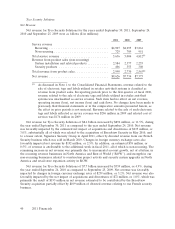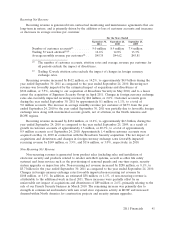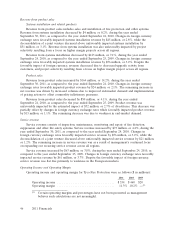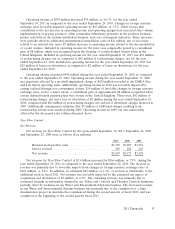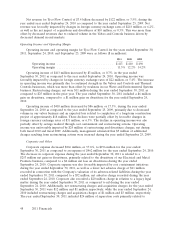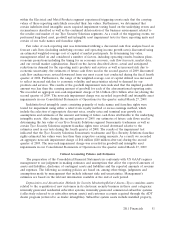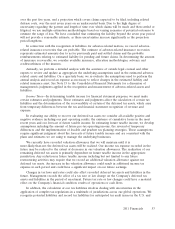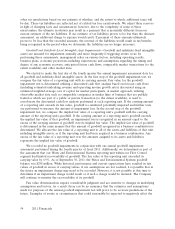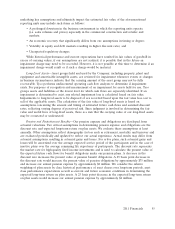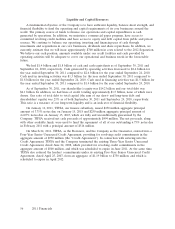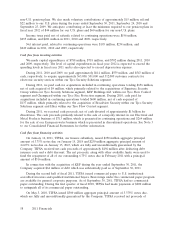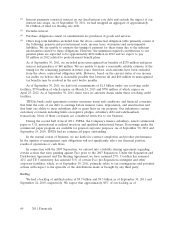ADT 2011 Annual Report Download - page 153
Download and view the complete annual report
Please find page 153 of the 2011 ADT annual report below. You can navigate through the pages in the report by either clicking on the pages listed below, or by using the keyword search tool below to find specific information within the annual report.related to the tax charge recorded in conjunction with the sale of a majority interest in our Electrical
and Metal Products business during the first quarter of 2011, a non-recurring transaction generating a
tax benefit in 2010 and a release of a deferred tax valuation allowance in 2010. The effective income
tax rate was positively impacted by favorable audit resolutions in multiple jurisdictions during 2011. The
rate can vary from quarter to quarter due to discrete items such as the settlement of income tax audits
and changes in tax laws, as well as recurring factors, such as the geographic mix of income before taxes.
The effective income tax rate for 2009 is not meaningful primarily as a result of the loss driven by
goodwill impairment charges of $2.6 billion for which almost no tax benefit was available. Additionally,
taxes for 2009 were positively impacted by increased profitability in lower tax rate jurisdictions and
release of contingency reserves partially offset by enacted tax law changes and changes in foreign
exchange rates that negatively impacted the non-U.S. deferred tax assets.
The valuation allowance for deferred tax assets of $1,400 million and $1,379 million as of
September 30, 2011 and September 24, 2010, respectively, relates principally to the uncertainty of the
utilization of certain deferred tax assets, primarily tax loss and credit carryforwards in various
jurisdictions. The valuation allowance was calculated and recorded when the Company determined that
it was more-likely-than-not that all or a portion of our deferred tax assets would not be realized. The
Company believes that it will generate sufficient future taxable income to realize the tax benefits
related to the remaining net deferred tax assets on the Company’s Consolidated Balance Sheets.
The calculation of our tax liabilities involves dealing with uncertainties in the application of
complex tax regulations in a multitude of jurisdictions across our global operations. We record tax
liabilities for anticipated tax audit issues in the U.S. and other tax jurisdictions based on our estimate
of whether, and the extent to which, additional taxes will be due. These tax liabilities are reflected net
of related tax loss carryforwards. We adjust these liabilities in light of changing facts and circumstances;
however, due to the complexity of some of these uncertainties, the ultimate resolution may result in a
payment that is materially different from our current estimate of the tax liabilities. Substantially all of
these potential tax liabilities are recorded in other liabilities in the Consolidated Balance Sheets as
payment is not expected within one year.
2009 Goodwill and Intangible Asset Impairments
Annually in the fiscal fourth quarter, and more frequently if triggering events occur, we test
goodwill and indefinite-lived intangible assets for impairment by comparing the fair value of each
reporting unit or indefinite-lived intangible assets with its carrying amount.
We began to experience a decline in revenue during the first quarter of 2009 in our Tyco Security
Solutions and Tyco Fire Protection segments as a result of a slowdown in the commercial markets,
including the retailer end market as well as a decline in sales volume at our Electrical Metal Products
segments. Although we considered and concluded that these factors did not constitute triggering events
during the first quarter of 2009, the continued existence of these conditions during the second quarter
of 2009, along with downward revisions to forecasted results, restructuring actions and weaker industry
outlooks, caused us to conclude that sufficient indicators of impairment existed. Reporting units within
our Tyco Security Solutions and Tyco Fire Protection segments continued to be negatively impacted as
a result of a slowdown in the commercial markets including the retailer end market. Additionally, our
Electrical Metal Products reporting unit continued to be negatively impacted by a decline in sales
volume due to the downturn in the non-residential construction market. We determined that these
underlying events and circumstances constituted triggering events for six reporting units where such
events would more likely than not reduce the fair value below their respective carrying amounts.
Specifically, we concluded that our EMEA Security, ACVS and Sensormatic Retail Solutions (‘‘SRS’’)
reporting units within the Tyco Security Solutions segment the EMEA Fire and Life Safety reporting
units within the Tyco Fire Protection segment and our Electrical and Metal Products reporting unit
50 2011 Financials


